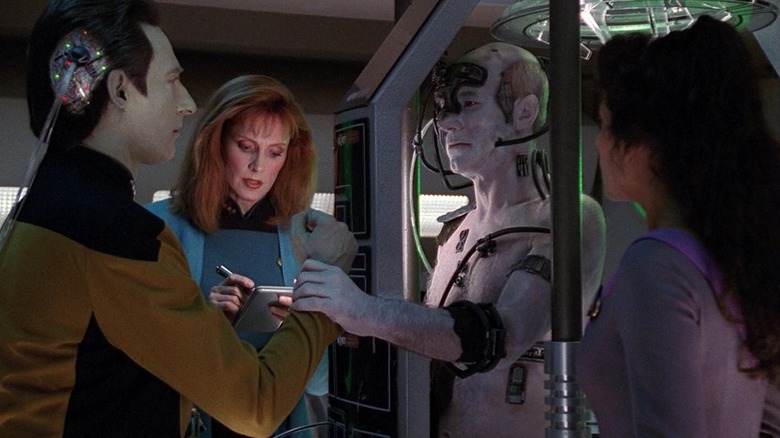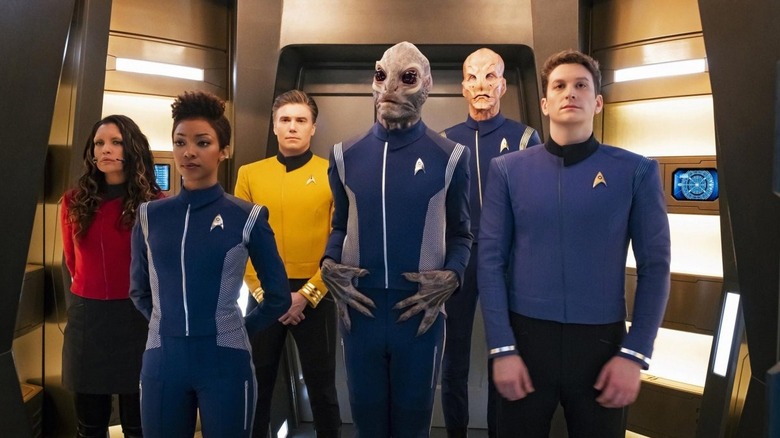
The overwhelming financial success of “Star Trek” can only be ironic. “Star Trek,” after all, takes place in a post-capitalist utopia wherein money has become a thing of the past, and want has been largely defeated. Reallocating resources is easy in the world of “Star Trek,” as they have faster-than-light starships that can bring medical supplies to the sick, and matter replicators can instantaneously create food and clothing for the hungry and cold. Here on Earth in the year 2025, however, the makers of “Star Trek” are rolling in gold-pressed latinum. The ubiquity of the popular franchise across multiple streaming platforms has continued to generate huge amounts of revenue for Paramount, its holding company, for the last few years.
The Wrap has reported (via the Parrot Analytics streaming economics platform) that “Star Trek” has — from January 2020 to December 2024 — raked in $2.6 billion worldwide.
It’s worth remembering that Paramount is earning revenue from, essentially, two different “Star Trek” sources. The company’s streaming service, CBS All Access (later Paramount+) launched in 2014, and brought in a new spate of subscribers in 2017 with the premiere of “Star Trek: Discovery,” the first “Star Trek” TV series since the end of “Star Trek: Enterprise” in 2005. Paramount soon started putting all their eggs in the “Star Trek” basket, launching five additional new “Star Trek” shows in the next five years (including “Short Treks,” “Picard,” “Lower Decks,” “Prodigy,” and “Strange New Worlds”). It was a new renaissance for the franchise, and the overwhelming volume of new sci-fi adventures began to match that of Trek’s heyday.
But in addition to the fresh subscribers that Paramount was attracting with their all-new starship adventures, the company is still earning revenue from old-school reruns. The $2.6 billion includes Paramount’s lucrative licensing fees to other streaming services like Netflix. Paramount+ may be netting new viewers with new Treks, but many are still tuning in to the adventures of Kirk, Picard, Sisko, Janeway, and Archer.
People still love Star Trek reruns
One should recall that “Star Trek” has been famously generous with streamers. Although Paramount has its own streaming service in Paramount+, the company was never shy about renting older “Star Trek” shows out to any and all eager takers. According to a graph on the Wrap’s report, Netflix accounts for just under $200 million in “Star Trek” profits, while Hulu accounts for just under $150 million. Prime Video alone earned Paramount about $220 million in “Star Trek” sales. The graph also shows that more and more people are coming to “Star Trek” all the time. Even a 38-year-old TV series like “Star Trek: The Next Generation” was keeping viewers hooked.
“Star Trek” became ubiquitous in the home video because of, weirdly enough, Janet Jackson’s wardrobe malfunction at Super Bowl XXXVIII. The Super Bowl was broadcast by CBS, but the scandalous Halftime Show was produced by MTV, both of which were owned by the media conglomerate Viacom. The scandal following the 2004 nipple incident inspired a lot of CEO infighting and, eventually, a split within Viacom. Reminder: Viacom also owned Paramount, which owns “Star Trek.”
The split, in what Trekkies see as a bureaucratic mess, placed the TV rights to “Star Trek” with CBS and the movie rights with Paramount. To generate revenue with their TV shows, CBS began to release “Star Trek” on DVD incessantly, and, when streamers became a thing, rented out “Star Trek” to them as often as they could. “Star Trek” could be seen on Prime, Netflix, Hulu, and just about any major service that would want it. These actions by CBS kept “Star Trek” very much in the public eye, inviting old-school Trekkies and newfound fans to binge-watch their favorite Starfleet adventures repeatedly.
Just like in the 1970s, “Star Trek” thrived in reruns. Money kept flowing in.
The benefits of streaming over old-school TV broadcasts
Paramount, meanwhile, was only permitted to make “Star Trek” movies. They responded to the Viacom split by licensing “Star Trek” from the CBS arm of the company and making a legally distinct “Star Trek” feature film in 2009. It’s a good thing Trek plays around in parallel universes so often, as it allowed J.J. Abrams to create an alternate dimension for the Enterprise that was nonlitigious.
In 2019, after Paramount+ was already a thing and CBS was already overseeing multiple new “Star Trek” shows, Viacom finally re-merged, bringing the “Star Trek” rights back together. No theatrically released “Star Trek” films have yet been made since the re-merge, but January 2025 saw the release of Olatunde Osunsanmi’s action thriller “Star Trek: Section 31” on Paramount+. The film wasn’t terribly well-received, but it was a proper “Star Trek” movie, the first since “Star Trek Beyond” in 2016. The movies and the TV shows are now all under the same umbrella, and Paramount can make huge profits by renting out enormous “packages” of “Star Trek” to streamers.
The larger streaming packages were likely more attractive to Paramount than the ones the company had to agree to back in the 1990s. Back in 1994, “Star Trek: The Next Generation” was coming to an end. This was odd, as the show was still a ratings bonanza. According to then-executive-producer Rick Berman, though, it was getting harder and harder to sell “Next Generation” to local TV stations, as the stations would have to agree to rerun each episode multiple times. With seven full seasons of an increasingly expensive show, fewer and fewer TV stations wanted to make that time commitment. After a while, continuing with “NextGen” just wasn’t economically feasible.
With streaming, though, everything is on-demand, and time constraints are no longer a concern. Now, Paramount could chunk together multiple Trek shows and sell them to streamers hungry for content. And they did.
The deal Netflix made with Star Trek: Discovery
When it comes to the newer “Star Trek” shows — “Star Trek: Discovery” in particular — one can point directly to Netflix for its success. Back when the series was still being filmed, CBS struck a deal with Netflix allowing the streamer to be the show’s exclusive distributor overseas. The deal raked in $6 million to $7 million per episode, which pretty much covered the expenses incurred to make the series. “Discovery” may have been criticized by old-school Trekkies, but CBS was all-in on the series, releasing it everywhere. Like the old-school “Star Trek” reruns, the new Trek shows benefited from being everything, everywhere, all at once.
Netflix continued to fund “Discovery” in a similar fashion for its first three seasons, allowing CBS to play with the franchise. With so much of its expenses being recouped, “Star Trek” could remain prolific. It wouldn’t be until 2020 and the re-merging of Viacom that Paramount would announce it could handle international distribution by itself. Thanks to Netflix, though, Paramount+ became a larger player in the streaming wars, so the move was hardly foolhardy. It didn’t hurt that Paramount also had hits with “Yellowstone” (and its spinoffs) and continued to make money from “SpongeBob SquarePants.”
As of this writing, Paramount is about to merge with Skydance Media, a merger set to take effect on March 20, 2025. A lot of the more recent “Star Trek” shows have been canceled (only “Strange New Worlds” remains), and the future of the franchise looks to be smaller than it was during the early CBS All Access days. Despite the financial troubles for Paramount as a whole, though, “Star Trek” is keeping it going. So don’t feel bad about watching a “Deep Space Nine” episode for the fourth time. You’re likely assuring that “Star Trek” will continue.





Leave a Reply